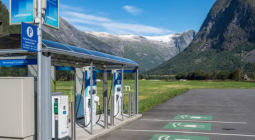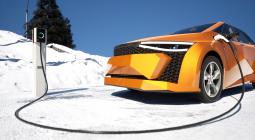'It symbolises rugged individualism': The bumpy road to electrify the pickup truck
It is America's best-loved truck – but how will it evolve in an age struggling with climate change?
The pickup truck is perhaps the most iconic vehicle in the US. In 2023, Ford's F-series model was the top-selling vehicle in the country for the 42nd year in a row, with sales exceeding 700,000 trucks. As a whole, sales of larger vehicles are soaring: SUVs and light trucks (pickups and minivans) account for around three in every four new vehicles bought in the US, according to the US Environmental Protection Agency (EPA).
As demand grows for EVs, car companies have started rolling out electric versions of the pickup truck. Ford, Chevrolet, Rivian and Tesla have all brought electric pickup trucks to market in recent years. Analysis by the Massachusetts Institute of Technology (MIT) shows that electric trucks produce half the emissions of a traditional pickup over their lifetimes.
With its electric pickup, the F-150 Lightning, Ford has aimed to attract new customers "who were previously resistant to get into pickup trucks before they became electrified because of the emissions impact", the company's chief sustainability officer Bob Holycross tells the BBC.
But creating a new market for pickup trucks, even electric ones, has its own climate problems. And electrifying this iconic American vehicle isn't straightforward. From developing big enough batteries to power these behemoths to providing affordable alternatives, companies face significant hurdles. What will it take for the electric pickup to catch up?
A 100-year history
The pickup truck has a long history in the US, dating back to the early 20th Century. The first pickups were used during World War One, when there was growing demand for a "utility vehicle", says John Heitman, professor emeritus specialising in the history of the automobile at the University of Dayton in Ohio.
In 1925, Ford introduced its lightweight model T truck. It cost $281 (£58.60) and the company sold 33,800 units that year.
By the 1930s other competitors, including Chevrolet, General Motors and Studebaker, had entered the market and were selling pickup trucks to farmers and labourers. "It was a rugged working vehicle," says Heitman. The vehicles were basic, humble and utilitarian. But by the late 1960s, the pickup truck started to appear in suburban driveways. "We start seeing a transition at this time as more and more people choose a vehicle that gives them self-reliance and makes a statement about independence… a vehicle that says, 'We are taking care of ourselves and maintaining our properties'," says Heitman.
In the early 2000s, the pickup truck transformed into a luxury car, kitted out with air conditioning, automatic transmissions and upgraded interiors, adds Heitman. "Manufacturers had every reason to push pickups, from the absence of environmental controls to high profits."
Today, pickups are as much about making a statement as they are a vehicle with a use. Heitman believes the pickup remains so popular largely because it is "equated with independence and individuality".
"For some, it tells us the owner is used to hard manual labour. For others, it evokes the image of the cowboy, the farmer or the large landowner," he says. "It symbolises rugged individualism, self-sufficiency, anti-authoritarianism, militarism, and a do-it-yourself attitude."
Dirty trucks
This tough image has come at a considerable cost for the climate.
Transport is the largest source of greenhouse gas emissions in the US, and light-duty vehicles, such as sedans, SUVs and pickup trucks, are the largest source of US transport sector emissions, accounting for 57%.
While US cars are overall becoming more fuel-efficient and less polluting, consumer demand for large cars is diminishing many of these climate gains, according to the EPA. The weight and footprint of the average vehicle in the US is at a record high, while cars in the EU are growing 1cm (0.4in) wider every two years. (Read more in Adrienne Bernhard's story: Are cars getting too big for the road?)
According to the EPA's 2023 automotive trends report, of the four largest vehicle types (sedan, pickup truck, SUV and minivan), "all vehicle types are at record low CO2 emissions". But the EPA notes that "market shifts away from cars and towards SUVs and pickups have offset some of the fleetwide benefits".
By 2035, the International Energy Agency (IEA) says there will need to be 790 million EVs on roads worldwide to hit the mid-century net zero target, up from less than 45 million in 2023.
"A shift to an electric vehicle is one of the single most impactful decisions that someone can make if they want to reduce their own emissions," says Jessika Trancik, professor of energy studies at the Massachusetts Institute of Technology (MIT) in Boston.
Trancik says electric pickup trucks produce emissions savings of between 30-60%, depending on the model and the location, compared with traditional pickups – a greater reduction than switching a smaller car to electric.
Trancik's team at MIT have created an online tool, called Carboncounter, which analyses the climate impact of about 1,000 different cars. According to Carboncounter, the F-150 Lightning produces 50% fewer greenhouse gas emissions per mile than the non-electric version.
"That includes the emissions that are incurred when you're producing the battery and building the vehicle," says Trancik.
However, electrification alone isn't a cure-all.
As electric cars get bigger and bulkier, their climate impact and environmental footprint also worsen, experts warn. Larger batteries are needed to power heavier electric pickup trucks, and manufacturing these is, currently, an energy-intensive process. Charging these big batteries also requires large amounts of electricity from the grid, the majority of which still comes from fossil fuels in the US.
Charging and manufacturing emissions aren't the only environmental concern with EVs. Lithium-ion batteries, which power EVs, are also difficult to recycle and extracting the lithium requires huge amounts of energy and water.
Manufacturing an electric pickup emits more than producing a petrol or diesel pickup, Carboncounter's analysis shows. But when the driving is factored in, emissions are much lower across the entire lifecycle of the vehicle.
"You're doing more extraction for the battery and less for the fuel in the electric vehicle… the comparison still comes out in favour of the electric vehicle," says Trancik.
A study by scientists at the University of Michigan found that electric sedans, SUVs and pickups powered by batteries have 64% lower greenhouse gas emissions over their lifetimes than internal combustion engine (ICE) vehicles on average across the US.
Replacing an ICE pickup with a battery-electric one saves 74 tonnes of carbon dioxide equivalent (CO2e) over the lifetime of the vehicles, according to the study. This saving is equivalent to the emissions from driving 189,260 miles (304,580km) in an average ICE car.
The researchers also noted that battery-electric vehicles have larger greenhouse emissions during the manufacturing process, due to battery roduction, but that this is offset by savings in their operation.
As the US decarbonises its electricity grid and renewable electricity becomes more abundant, EV emissions will continue to fall, says David Reichmuth, an expert in new vehicle technologies at US non-profit the Union of Concerned Scientists. "The net benefit of switching to an EV will increase over time," he says.
Reichmuth says it is important for consumers to choose the most efficient vehicle that meets their mobility needs. "If people need a pickup truck for their livelihood, then we definitely see that switching from a gasoline to an electric version has huge climate benefits," says Reichmuth.
But if people are trading in their small petrol car for an electric pickup, "you can still have a climate benefit, but you're going to have much less of a benefit than if you switch from a small gasoline car to a smaller electric car," he says.
Despite the clear environmental benefits of switching to electric models, the pickup's electrification still faces a few bumps in the road.
Ford recently postponed the launch of its next electric pickup truck, the successor to its F-150 Lightning. The Michigan carmaker had initially planned to start production of the electric truck next year in Tennessee, but the launch has now been pushed back to 2027.
A number of factors have led to this delay, including the development of new battery technology and Ford's realisation that it needs to offer lower-cost pickup trucks. "Taking the cost out of the product is certainly driving our evolving strategy," says Holycross.
The high price of electric pickup trucks is a barrier preventing many consumers from upgrading to an EV, according to Trancik and Reichmuth.
There is a higher upfront cost when buying an electric pickup compared with a non-electric truck. The F-150 Lightning prices start at $62,995 (£47,680), compared with $38,610 (£29,221) for its non-electric pickup. Chevrolet's Silverado electric pickup starts at $96,495 (£73,032), compared with $38,795 (£29,366) for the non-electric version.
According to MIT's Carboncounter, purchasing a F-150 Lightning pickup costs $390 (£296) per month compared to $312 (£236) for the non-electric version, but monthly maintenance and fuel costs are significantly lower for the electric car ($131/£99, compared with $259/£196).
Car companies developing electric pickups are "targeting the luxury pickup buyer", says Reichmuth, adding that as demand and charging infrastructure increases companies are likely to offer more affordable models. Tesla took a similar approach, starting with the Tesla Model S, a luxury sedan, before moving into less expensive vehicles, he notes.
Currently, electric pickup trucks remain out of reach for a lot of consumers, says Reichmuth. "If you're a business that has a fleet of pickup trucks and you're looking to buy the cheapest option to meet your utility needs, that product is not available."
Much of this cost challenge is down to the battery, which can account for half the total cost of the vehicle, says Trancik. "You do need a lot of battery power because it's heavier," says Trancik. "It's less efficient [than a smaller car] when it's operating because you have that higher drag and it's less streamlined."
The upfront costs of buying an electric pickup are expected to decline as the price of lithium-ion batteries continues to fall, she adds. The cost of lithium-ion batteries has fallen by 97% since they were first commercially introduced in 1991, according to a 2021 study by Trancik. "They improved in cost by about 10% per year" between 1991 and 2021, says Trancik.
"Looking at it from a climate perspective, you really want those lower-cost models that are going to be more widely affordable if you want to bring overall emissions down," says Trancik.
Holycross says that one of the new electric pickups that Ford is launching is a mid-sized truck that will be less expensive than the F-150 Lightning. "That is coming in 2027 and is going to help with cost and also appeal to a wider range of truck buyers who maybe don't need the capability of a full-size truck," he says.
Electrifying the pickup truck, however, leaves one big flaw of these vehicles still unaddressed: the safety issues associated with size. Pedestrians hit by light trucks (SUVs and pickups) have been found to suffer higher rates of mortality and brain injury, a 2021 analysis found. "There is a concern with the design of the current pickup truck – the height of the vehicle, the flat front and the limited visibility," says Reichmuth. "Safety is not an issue with electric cars [specifically] but with the way pickup trucks are designed." (Read more about the risks in our story here.)
This is just one issue that car companies will need to solve as they move towards electrification. "It's called a transition for a reason – it's not happening overnight. It's quite a complicated problem to solve," says Trancik. "But the situation is changing as you see more charging infrastructure become available and as people get more used to the changes that are associated with an electric vehicle."
Cover photo: Getty Images




